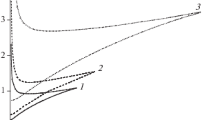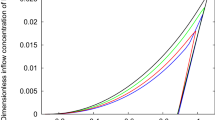Abstract
This paper investigates the bifurcation behaviour of a model oxidation reaction in a continuously stirred tank reactor (CSTR). We assume that two gaseous chemical species are pumped separately into the CSTR, at constant total pressure, reacting to produce an inert product. The reaction is assumed to be a single step reaction that is described by Arrhenius kinetics. It is capable of producing oscillatory behaviour as well as steady state multiplicity in certain parameter regions. Bifurcation diagrams in various control parameter spaces are presented. We show that the system always possesses a globally attracting invariant region. The equivalence of a CSTR having n feed streams and the one pipe version, by appropriate rescaling, is also discussed.
Similar content being viewed by others
References
I.R. Epstein and J.A. Pojman, An Introduction to Nonlinear Chemical Dynamics (Oxford University Press, New York, 1998).
R.J. Field and M. Burger, Oscillations and Travelling Waves in Chemical Systems (Wiley, New York, 1985).
P. Gray and S.K. Scott, Chemical Oscillations and Instabilities (Clarendon Press, Oxford, 1994).
Ya.B. Zeldovich, I. Zh. Tekh. Fiz. 11 (1941) 493.
C. van Heerden, Ind. Engrg. Chem. 45 (1953) 1242.
O. Bilous and N.R. Amundson, AIChE J. 1 (1955) 513.
R. Aris and N.R. Amundson, Chem. Engrg. Sci. 7 (1958) 121.
R. Aris and N.R. Amundson, Chem. Engrg. Sci. 7 (1958) 132.
R. Aris and N.R. Amundson, Chem. Engrg. Sci. 7 (1958) 148.
V. Hlavacek, M. Kubicek and J. Jelinek, Chem. Engrg. Sci. 25 (1970) 1441.
A. Uppal, W.H. Ray and A.B. Poore, Chem. Engrg. Sci. 29 (1974) 967.
A. Uppal, W.H. Ray and A.B. Poore, Chem. Engrg. Sci. 31 (1976) 205.
V. Balakotaiah and D. Luss, Chem. Engrg. Commun. 13 (1981) 111.
V. Balakotaiah and D. Luss, Chem. Engrg. Commun. 19 (1982) 185.
V. Balakotaiah and D. Luss, Chem. Engrg. Sci. 37 (1982) 433.
V. Balakotaiah and D. Luss, Chem. Engrg. Sci. 37 (1982) 1611.
V. Balakotaiah and D. Luss, Chem. Engrg. Sci. 38 (1983) 1709.
V. Balakotaiah and D. Luss, Chem. Engrg. Sci. 39 (1984) 865.
W.W. Farr and R. Aris, Chem. Engrg. Sci. 41 (1986) 1385.
J.B. Planeaux and K.F. Jensen, Chem. Engrg. Sci. 41 (1986) 1497.
R. Ball and B.F. Gray, Ind. Engrg. Chem. Res. 34 (1998) 3726.
D. Drysdale, Limits of Flammability and Premixed Flames (Wiley, New York, 1999).
D.L. Baulch, J.F. Griffiths, A.J. Pappin and A.F. Sykes, Combust. Flame 73 (1988) 163.
B.R. Johnson, S.K. Scott and A.S. Tomlin, J. Chem. Soc. Faraday Trans. 87 (1991) 2539.
F.A. Williams, Combustion Theory, 2nd ed. (Benjamin, New York, 1985).
M.I. Nelson, H.S. Sidhu, R.O. Weber and G.N. Mercer (under preparation).
H.S. Sidhu, M.J. Sexton, M.I. Nelson, G.N. Mercer and R.O. Weber, in: Proc. Eng. Math. Appl. Conf. (2000) p. 251.
B.R. Johnson, J.F. Griffiths and S.K. Scott, J. Chem. Soc. Faraday Trans. 87 (1991) 523.
B.F. Gray, Merkin, G.C. Wake, Math. Comput. Modelling 15 (1991) 25.
E. Balakrishan, M.I. Nelson and G.C. Wake, Math. Comput. Modelling 30 (1999) 177.
F.P. Di Maio, G. Barbieri and P.G. Lignola, J. Chem. Soc. Faraday Trans. 92 (1996) 2989.
R. Seydel, Practical Bifurcation and Stability Analysis: From Equilibrium to Chaos (Springer-Verlag, New York, 1994).
E.J. Doedel, T.F. Fairgrieve, B. Sandstede, A.R. Champneys, Y.A. Kuznetsov and X. Wang, AUTO97: Continuation and bifurcation software for ordinary differential equations (with HomCont) (1998).
Y.A. Kuznetsov, Elements of Applied Bifurcation Theory (Springer-Verlag, New York, 1998).
B.F. Gray and J.C. Jones, Combust. Flame 57 (1984) 3.
B.F. Gray and L.K. Forbes, Proc. Roy. Soc. London Ser. A 443 (1994) 621.
H.S. Sidhu, L.K. Forbes and B.F. Gray, Proc. Roy. Soc. London Ser. A 449 (1995) 493.
J. Tóth, J. Math. Chem. 25 (1999) 393.
D.P. Copperthwaite, J.F. Griffiths and B.F. Gray, J. Phys. Chem. 95 (1991) 6961.
B.F. Gray and M.J. Roberts, Proc. Roy. Soc. London Ser. A 416 (1988) 361.
D.B. Spalding, Proc. Roy. Soc. London Ser. A 240 (1957) 83.
Author information
Authors and Affiliations
Rights and permissions
About this article
Cite this article
Sidhu, H., Nelson, M., Mercer, G. et al. Dynamical analysis of an elementary X + Y → P reaction in a continuously stirred tank reactor. Journal of Mathematical Chemistry 28, 353–375 (2000). https://doi.org/10.1023/A:1011043005019
Issue Date:
DOI: https://doi.org/10.1023/A:1011043005019




